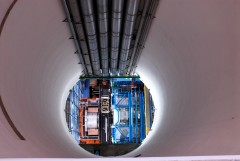|
The European Organization for Nuclear Research (Organisation Européenne pour la Recherche Nucléaire), commonly known as CERN (the acronym originally stood, in French, for Conseil Européen pour la Recherche Nucléaire — European Council for Nuclear Research, which was a provisional council for setting up the laboratory, established by 11 European governments in 1952. The acronym was retained for the new laboratory after the provisional council was dissolved), is the world’s largest particle physics laboratory, situated just west of Geneva on the border between France and Switzerland. It is also known for being the birthplace of the World Wide Web. The convention establishing it was signed on 29 September 1954. From the original 12 signatories of the CERN convention, membership has grown to the present 20 member states.
The LHC, accelerator for the 21st century, will take over from LEP in 2007. This new generation of particle collider, the most powerful ever built, will allow some 5,000 physicists from all over the world to study the mysteries of matter and let them "see" back to the start of the Universe. The LHC represents 5,000 man years of engineering effort from CERN and its collaborating institutes. European industry in the CERN members states will produce 80% of the components for the LHC. The other 20% will be provided by non-member states.
The extensive use of state-of-the-art technologies such as superconductivity has allowed a considerable increase in performance while at the same time reducing the power consumption. The LHC makes maximum use of the LEP tunnel and CERN’s existing accelerator complex. The LHC will be housed in the LEP tunnel (27 km in circumference and 100 meters underground) which sits astride the Franco-Swiss border close to Geneva.
The two beams of protons or heavy ions go in opposite directions inside two ultra-high vacuum tubes which cross at four places. It is at these intersection points that the detectors of the experiments, ATLAS, ALICE, CMS and LHCb will observe collisions.
The ATLAS detector, whose name stands for "A Toroidal LHC Apparatus" is an ambitions and powerful large multi-purpose experiment for the LHC. It will explore new domains of fundamental particle physics. The detector is constructed and financed by a worldwide collaboration from 150 institutions in 34 countries. The ATLAS detector will be 22 meters high, 45 meters long and weight some 7,000 metric tons. In an unprecedented way it will combine front-line technologies from many areas, ranging from highly integrated semiconductor micro-detectors, high-speed data transmission and processing, to one of the largest superconducting magnet structures ever built. The ATLAS detector requires some 80 metric tons of plastic material, called scintillators, which glow when charged particles pass through it. In ATLAS they will be used in the shape of tiles to form a part of the detector called the hadronic calorimeter. This will measure the energy of particles emerging from collisions between LHC protons.
The CMS detector is a high-performance general-purpose detector whose goal is to seek out new physics, whatever form it may take. The detector, weighting 12,500 metric tons, was designed and is currently being built by a world-wide collaboration of 1,800 physicists from 32 countries. CMS is a large, technologically-advanced detector made up of many layers. Each of these is designed to perform a specific task and together they will allow CMS to identify and precisely measure the energy of all the particles produced in LHC proton-proton collisions. The layers of the CMS detector are arranged in concentric cylinders around the collision point. Central to the design of CMS is the biggest superconducting solenoid magnet with the highest field and stored energy ever. The solenoid will be 6 meters in diameter and 13 meters long. It will generate a field of 4 Tesla, which means that the energy stored will be 2.5 Giga Joules, enough to melt 18 metric tons of gold. All in all, CMS will have 15,000,000 individual electronics channels, controlled by powerful computers, from which information from the detector is readout. A high precision electromagnetic calorimeter made of Lead Tungstate (PbWO4) crystals optimised for the detection of key processes sits inside the magnetic field. CMS will need 80,000 blocks of these crystals for a total volume of 11 m3 and a weight of 90 metric tons. In order to produce these over the five year timescale required, the world’s production rate would have to be substantially increased.
Click on thumbnails for a larger version
|
 CERN’s Large Hadron Collider (LHC)
CERN’s Large Hadron Collider (LHC)











